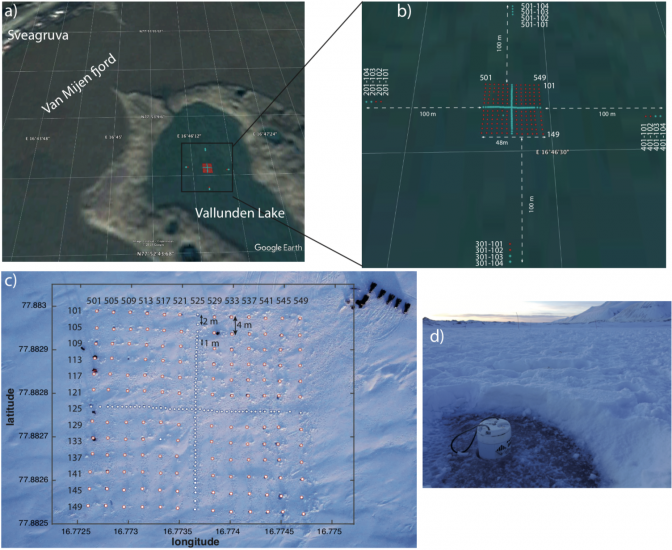WP1 | Seismic experiment in Svalbard
4 octobre 2018 ( maj : 30 janvier 2020 ), par
WP1 consists in the deployment of a dense array of one- and three-components geophones on the ice cover that builds up during winter on the Lake.
Attempts to install geophones on the frozen lakes of the Alps were not successful. This was due to to unreliable weather conditions (not cold enough) for a deployment of our sensors for several days. Hence the Icewaveguide experiement took place directly on first year sea ice in the Arcitc, in the Van Mijen fjord near Sveagruva (Svalbard) See the map. A total of 247 FairFieldNodal Zland geophones were deployed. This part of the fjord, located 2 km South-East of Sveagruva, is surrounded by a moraine. Because of its connection to the fjord by a canal, Vallunden Lake is subject to tidal flows and forcing. It is a quiet zone that is well suited for scientific experiments on sea ice.
The seismic array was divided into five zones, including one large, two-dimensional array, and four smaller linear arrays. The main array is a large squared area with sides of length 48 m. The other four arrays consist of four stations with an aperture of 12 m. The array is shown in the figure below.

Based on an ice thickness of 50 cm, the spatial sampling of the 1C geophones in the main array (four meters) is sufficient to measure the slowest mode, quasi-Scholte and the fastest mode, quasi-S0, in the [1-20] Hz and [30-250] Hz frequency ranges, respectively. With the denser spatial sampling of the 3C geophones (one meter), these two modes can be measured in extended frequency ranges : [1-150] Hz for quasi-Scholte and [30-500] Hz for quasi-S0. This high spatial density is not necessary for monitoring ice thickness and mechanical properties, because the guided wave problem is very well constrained. However, this experiment was intended to underpin research on the trade-off between accuracy and array density, and should help setting new benchmarks for future inversions of sea ice seismic data.
- Passive data acquisition. Ambient noise was recorded for the whole duration of the experiment to collect passive data in view application of the so-called ambient noise correlation processing.
- Active data acquisition. Three complementary sets of active data were recorded. The first one was obtained using a shaking unit. The second one with impulsive sources (jumps on the ice). The third one by driving smowmobiles around the array as artificial seismic noise sources.
- Ground Penetrating Radar data acquisition. For comparison purposes, two independent GPR profiles were measured along the North-South and East-West directions accross the main array ( 250m each), with a 800 MHz shielded antenna.
All the metadata of this experiment are accessible via the RESIF website. Moreover, a sample of 3 full days of seismsic data are made available for downloading (RSYNC link) via RESIF upon request to Ludovic Moreau (ludovic.moreau@univ-grenoble-alpes.fr).


